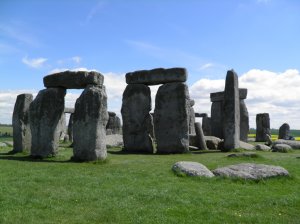Graham Reid | | 3 min read

A couple of years ago when Britain's English Heritage was again getting fretful over the increasing number of tourists arriving at Stonehenge on Salisbury Plain, a wag wrote a pithy one-liner to a major daily.
If whoever erected those monolithic stones was so smart, he asked, why did they build it near a motorway?
Certainly if you wander around the site in Wiltshire of this mysterious and imposing prehistoric monument to whatever, the drone and hiss of cars is audible. The A303 and A344 run near the stone circles, and on any given day the carpark disgorges busloads of visitors.
Quite what we go to Stonehenge to see is as mysterious as the stones themselves. A very large clock measuring the seasons; a shrine to ancestor worship; a place of pilgrimage and possibly sacrifice; a religious site . . .?
The first time I went at the close of the 60s, you could walk up and touch the stones. After free rock festivals in the mid Seventies and the famous '85 Battle of the Beanfield when New Age trippers descended en masse to celebrate the mid-summer solstice at the site (and were brutally beaten back by police), that practice was disallowed. Today you walk around a broad path and are kept at a safe distance from the manicured site, but the henge will always draw the curious – and a curious collection of people.

The attraction is that no one really knows what the hell it's all about. There are as many theories as there are scientists and crackpots who have applied themselves to a study of the place.
It's as much on the psychic ley lines of dopey heavy metal fans who have watched the mockumentary movie This is Spinal Tap (with the band's absurd stage prop of a miniature standing stone) as it is to professors Tim Darvill and Geoff Wainwright whose archeological dig in 2008 allowed them to theorise it had been an ancient healing centre.
They argued – persuasively, but with the customary leaps of faith required – that the smaller stones brought by raft from Wales some 250kms away were believed to have had therapeutic qualities.
So Stonehenge might have been a kind of outdoor A&E staffed by shamanistic healers.
Interestingly their dig was not only sanctioned by English Heritage and various other worthy groups, but also by Druids who turned up in robes, blew on a ram's horn and offered a blessing because this was a place of their ancestors. Well, maybe.
As writer Rob Young in Electric Eden observes, today's Druid cult originated in the 18th century when a new group emerged, the Ancient Order of Druids, who believed Britons were the descendants of Noah with bloodlines back to Adam. Uh-hu.
In 74 when an odd coagulation of hippie philosophers, Druids tracing their heritage way back to the Industrial Revolution, mystics and brain-fried acid freaks descended on the henge, one of them Wally Hope (aka Phil Russell who was a sun worshipper with a private income, according to Young) told a journalist, “We are men of God. We want to plant a Garden of Eden with apricots and cherries, where there will be guitars instead of guns and the sun will be our nuclear bomb”.
Still, we shouldn't blame Stonehenge for those who attach themselves to it. The magisterial quality of the standing stones translates well into our modern age, especially in television documentaries when time-lapse photography allows for dark clouds to scurry across the sky behind the tallest monoliths (spooky!) or we witness a sped-up sunset accompanied by a suitably foreboding and dramatic soundtrack. (Double spooky!!)
The money shot is sunrise on midsummer's day, although current thinking – ridiculously relative in relation to Stonehenge – says the important date was sunset on midwinter's day which marked the passing of one season and announced the coming spring and the planting of crops. Sort of the Bronze Age equivalent of Matariki.
 Perhaps it doesn't matter if we never
know what Stonehenge is all about, it might be better we don't.
Perhaps it doesn't matter if we never
know what Stonehenge is all about, it might be better we don't.
The draw of of the place is less the stones than the mystique which attends them. You can read a pile of books and stand in silent wonder for hours yet still come away no wiser.
In a world of smartphones with Celtic ringtones, the incessant witter of Twitter and real ale drinkers toasting pagan Britain in gastropubs, here is something ineffably ancient, and which was as distant to Imperial Rome in its heyday as we are from the Caesars.
Stonehenge is so far beyond our understanding that the mystery and wonder of it is mystery and wonder itself.
Rare commodities today.
And whoever built it, for whatever purpose, they had the good grace to do so on a site conveniently close to a motorway.





Linda Hubbard - Nov 19, 2012
You could do a course on it at University one year in the Archaeology department run by a Young English guy.
SaveGraham Dunster - Nov 19, 2012
I recently stumbled across an article in the Guardian trumping Stonehenge. Well worth reading - http://www.guardian.co.uk/science/2012/oct/06/orkney-temple-centre-ancient-britain?intcmp=239
SaveNathan Graves - Nov 19, 2012
I drove past Stonehenge about 3 weeks ago and was reminded how close they build it to the A303 when it appeared so quickly and so close as I whistled past! It is a remarkable site. A great binding of a book for dipping in and out of is the fried ex Teardrop Explodes - Julian Cope's - Stone Circle http://www.themodernantiquarian.com/home/
Savepost a comment